SAT数学知识点总结
- 格式:docx
- 大小:13.82 KB
- 文档页数:3
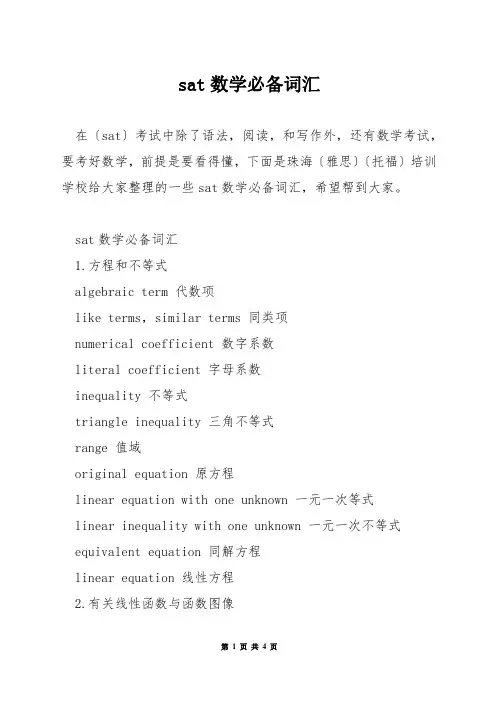
sat数学必备词汇在〔sat〕考试中除了语法,阅读,和写作外,还有数学考试,要考好数学,前提是要看得懂,下面是珠海〔雅思〕〔托福〕培训学校给大家整理的一些sat数学必备词汇,希望帮到大家。
sat数学必备词汇1.方程和不等式algebraic term 代数项like terms,similar terms 同类项numerical coefficient 数字系数literal coefficient 字母系数inequality 不等式triangle inequality 三角不等式range 值域original equation 原方程linear equation with one unknown 一元一次等式linear inequality with one unknown 一元一次不等式equivalent equation 同解方程linear equation 线性方程2.有关线性函数与函数图像function 函数coordinate system 坐标系rectangular coordinate 直角坐标系origin 原点abscissa 横坐标ordinate 纵坐标numberline 数轴quadrant 象限slope 斜率complex plane 复平面linear function 一次函数inverse proportional function 反比例函数 quadratic function 二次函数parabola 抛物线proportional function 正比例函数exponential function 指数函数logarithmic function 对数函数3。
集合subset子集union合集,并集intersection交集proper subset真子集solution set解集4.描述统计学average平均数median中数mode众数(在一系列数中出现多的数) arithmetic mean算术平均数weighted average加权平均数geometric mean几何平均数maximum大值minimum小值range值域(一系列数中大值减小值) dispersion差量,离差5.数学运算add/plus加subtract/minus减multiply/times乘divide除total1总数(用在加法中,相当于+); division1除;2部分divisible可被整除的divided evenly被整除dividend被除数divisor除数以上就是sat数学必备词汇的内容,希望对大家有所帮助哦。
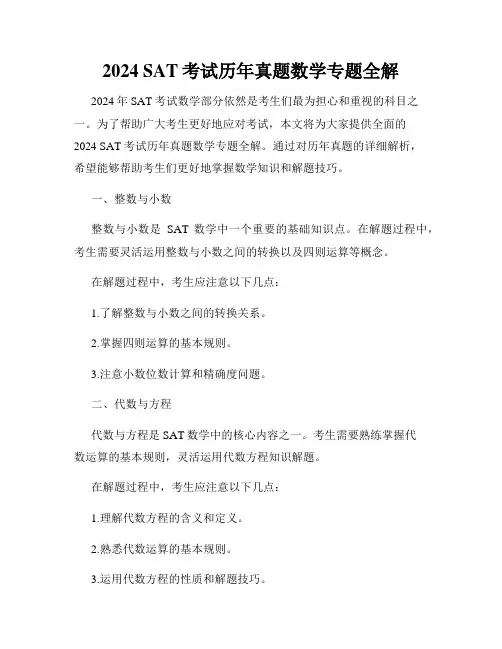
2024 SAT考试历年真题数学专题全解2024年SAT考试数学部分依然是考生们最为担心和重视的科目之一。
为了帮助广大考生更好地应对考试,本文将为大家提供全面的2024 SAT考试历年真题数学专题全解。
通过对历年真题的详细解析,希望能够帮助考生们更好地掌握数学知识和解题技巧。
一、整数与小数整数与小数是SAT数学中一个重要的基础知识点。
在解题过程中,考生需要灵活运用整数与小数之间的转换以及四则运算等概念。
在解题过程中,考生应注意以下几点:1.了解整数与小数之间的转换关系。
2.掌握四则运算的基本规则。
3.注意小数位数计算和精确度问题。
二、代数与方程代数与方程是SAT数学中的核心内容之一。
考生需要熟练掌握代数运算的基本规则,灵活运用代数方程知识解题。
在解题过程中,考生应注意以下几点:1.理解代数方程的含义和定义。
2.熟悉代数运算的基本规则。
3.运用代数方程的性质和解题技巧。
三、几何与三角学几何与三角学是SAT数学中的另一个重要内容。
考生需要掌握几何图形的性质和运算规则,灵活运用三角学知识解题。
在解题过程中,考生应注意以下几点:1.掌握几何图形的基本性质和定义。
2.熟练运用三角学的相关概念和运算规则。
3.注意几何图形的变换和投影等问题。
四、数据与统计数据与统计是SAT数学中的重要内容之一。
考生需要了解数据分析和统计学的基本概念,掌握数据处理和统计方法。
在解题过程中,考生应注意以下几点:1.熟悉数据分析和统计学的基本概念。
2.掌握数据处理和统计方法。
3.灵活运用数据与统计知识解题。
五、概率与排列组合概率与排列组合是SAT数学中的难点之一。
考生需要掌握概率和排列组合的基本概念,灵活运用相关知识解题。
在解题过程中,考生应注意以下几点:1.理解概率和排列组合的基本概念。
2.熟悉概率和排列组合的运算规则。
3.注意概率和排列组合在实际问题中的应用。
通过对以上五个数学专题的全面解析与讲解,相信考生们已经对2024 SAT考试数学部分有了更深入的理解与掌握。

sat数学知识点总结在SAT数学部分中,主要涉及到初中和高中的数学知识。
以下是一些重要的数学知识点和技巧,用于备考SAT数学部分。
代数1. 代数基本技巧代数基本技巧包括整数运算、分式运算、指数运算、根式运算、代数式的化简、代数式的展开和化简等等。
2. 一元一次方程一元一次方程是代数中最基本的线性方程。
解一元一次方程的方法包括变项消去法、分式消去法、相等法等等。
3. 一元一次不等式一元一次不等式是代数中的基本问题之一,解一元一次不等式的方法与解一元一次方程类似。
4. 一元二次方程一元二次方程也是一种重要的代数方程,其解法包括配方法、配方法与因式分解法等等。
5. 二元一次方程组二元一次方程组是两个未知数的线性方程组。
解二元一次方程组的方法包括代入消元法、加减消元法等。
6. 因式分解因式分解是将多项式化为各个不可再分解的因子之乘积。
因式分解的方法包括分解公因式法、分组因式法、配方法、特殊因式分解法等。
7. 分式方程分式方程是含有分式的代数方程。
解分式方程的方法包括通分法、化简法、移项法等。
8. 根式和指数根式和指数是代数中的重要概念。
总结求根式的基本方法、指数的基本运算规则、指数方程的解法等。
几何1. 基本图形基本图形包括直线、线段、射线、角、三角形、四边形、圆等。
了解基本图形的性质和运用。
2. 相似和全等相似和全等是几何中的重要概念。
了解相似和全等的定义、性质、判定方法等。
3. 勾股定理勾股定理是三角形中的一个重要定理。
了解勾股定理的概念和运用。
4. 圆圆是几何中的一个重要图形。
了解圆的性质、弧长、扇形面积、圆环等相关概念。
5. 平行线和垂直线平行线和垂直线是几何中的基本概念之一。
了解平行线和垂直线的性质、判定方法等。
6. 多边形多边形包括三角形、四边形、五边形、六边形等等。
了解多边形的性质、内角和外角的性质、对角线长度等。
7. 圆锥和圆柱圆锥和圆柱是常见的几何图形。
了解圆锥和圆柱的性质、面积和体积的计算方法等。
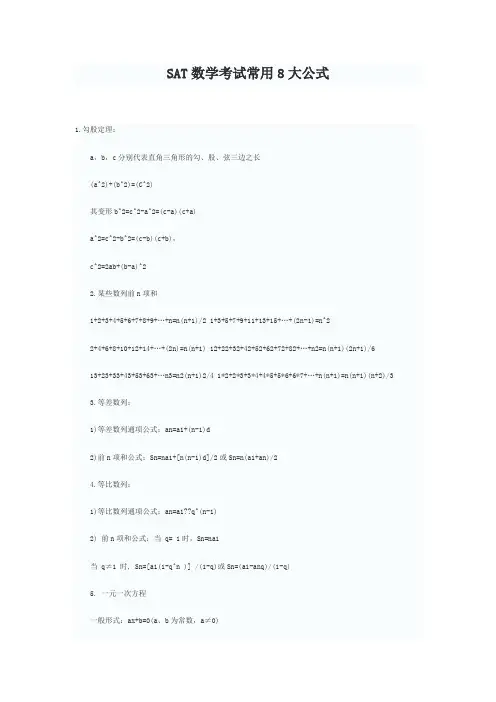
SAT数学考试常用8大公式1.勾股定理:a,b,c分别代表直角三角形的勾、股、弦三边之长(a^2)+(b^2)=(C^2)其变形b^2=c^2-a^2=(c-a)(c+a)a^2=c^2-b^2=(c-b)(c+b),c^2=2ab+(b-a)^22.某些数列前n项和1+2+3+4+5+6+7+8+9+…+n=n(n+1)/2 1+3+5+7+9+11+13+15+…+(2n-1)=n^22+4+6+8+10+12+14+…+(2n)=n(n+1) 12+22+32+42+52+62+72+82+…+n2=n(n+1)(2n+1)/613+23+33+43+53+63+…n3=n2(n+1)2/4 1*2+2*3+3*4+4*5+5*6+6*7+…+n(n+1)=n(n+1)(n+2)/33.等差数列:1)等差数列通项公式:an=a1+(n-1)d2)前n项和公式:Sn=na1+[n(n-1)d]/2或Sn=n(a1+an)/24.等比数列:1)等比数列通项公式:an=a1??q^(n-1)2) 前n项和公式:当 q= 1时,Sn=na1当q≠1 时, Sn=[a1(1-q^n )] /(1-q)或Sn=(a1-anq)/(1-q)5. 一元一次方程一般形式:ax+b=0(a、b为常数,a≠0)6.一元二次方程:一般形式:ax^2+bx+c=0(a、b、c为常数,a≠0)7. 韦达定理:一元二次方程ax^2+bx+c (a不为0)中设两个根为X1和X2则X1+X2= - b/aX1*X2=c/a8.阶乘1×2×3×……×n=x,x就是n的阶乘以上就是关于SAT数学常用公式的全部信息,包括了在SAT数学考试中常见的勾股定理,数列,方程等方面的公式。
大家可以在解答SAT数学题目的时候,对这些公式进行熟悉和应用,熟练之后,相信会对大家有很大的帮助的。
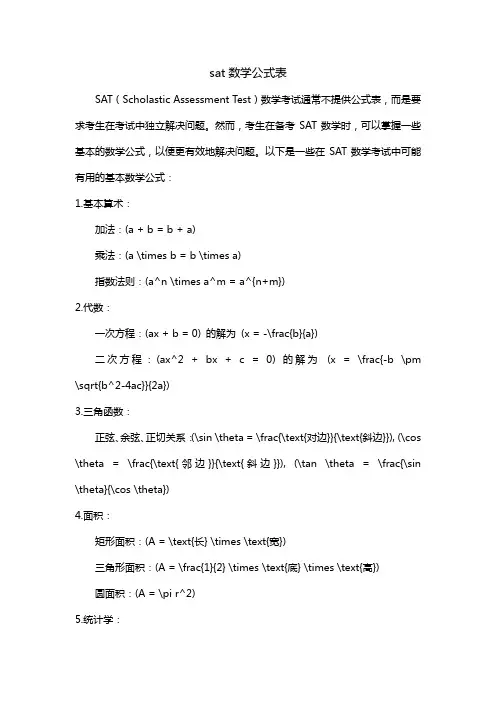
sat数学公式表SAT(Scholastic Assessment Test)数学考试通常不提供公式表,而是要求考生在考试中独立解决问题。
然而,考生在备考SAT数学时,可以掌握一些基本的数学公式,以便更有效地解决问题。
以下是一些在SAT数学考试中可能有用的基本数学公式:1.基本算术:加法:(a + b = b + a)乘法:(a \times b = b \times a)指数法则:(a^n \times a^m = a^{n+m})2.代数:一次方程:(ax + b = 0) 的解为(x = -\frac{b}{a})二次方程:(ax^2 + bx + c = 0) 的解为(x = \frac{-b \pm \sqrt{b^2-4ac}}{2a})3.三角函数:正弦、余弦、正切关系:(\sin \theta = \frac{\text{对边}}{\text{斜边}}), (\cos \theta = \frac{\text{邻边}}{\text{斜边}}), (\tan \theta = \frac{\sin \theta}{\cos \theta})4.面积:矩形面积:(A = \text{长} \times \text{宽})三角形面积:(A = \frac{1}{2} \times \text{底} \times \text{高})圆面积:(A = \pi r^2)5.统计学:平均值:(\text{平均} = \frac{\text{总和}}{\text{数量}})中位数:将数据按顺序排列,中间的值即为中位数。
这只是一小部分可能在SAT数学考试中用到的公式。
在备考过程中,建议参考SAT官方指南和真题,以了解更多具体要求和题型,并进行充分的练习。
记住,熟练掌握基本概念和解题技巧比记忆公式更为重要。

SAT数学之三角函数公式汇总三角函数是高中数学中的一个重要内容,也是数学竞赛中常常涉及的知识点。
了解和掌握三角函数的公式是解题的关键之一、在这篇文章里,我们将汇总一些常见的三角函数公式,希望能够帮助大家更好地理解和应用这些知识。
1.基本三角函数定义:正弦函数(Sine Function):y = sin(x)余弦函数(Cosine Function):y = cos(x)正切函数(Tangent Function):y = tan(x)其中,x为弧度值,y为函数的值。
2.基本三角函数关系:正弦函数与余弦函数的关系:sin(x) = cos(x - π/2)余弦函数与正弦函数的关系:cos(x) = sin(x + π/2)正切函数与正弦函数的关系:tan(x) = sin(x) / cos(x)正切函数与余弦函数的关系:tan(x) = cos(x) / sin(x)正切函数与余切函数的关系:tan(x) = 1 / cot(x)其中,cot(x)表示余切函数,cot(x) = 1 / tan(x)3.三角函数的周期性:正弦函数和余弦函数的周期都是2π,即sin(x + 2π) = sin(x)和cos(x + 2π) = cos(x)正切函数的周期是π,即tan(x + π) = tan(x)4.三角函数的奇偶性:正弦函数是奇函数,即sin(-x) = -sin(x)余弦函数是偶函数,即cos(-x) = cos(x)正切函数是奇函数,即tan(-x) = -tan(x)5.三角函数的差化积公式:sin(x ± y) = sin(x)cos(y) ± cos(x)sin(y)cos(x ± y) = cos(x)cos(y) ∓ sin(x)sin(y)tan(x ± y) = (tan(x) ± tan(y)) / (1 ∓ tan(x)tan(y))6.三角函数的和化积公式:sin(x + y) = sin(x)cos(y) + cos(x)sin(y)cos(x + y) = cos(x)cos(y) - sin(x)sin(y)tan(x + y) = (tan(x) + tan(y)) / (1 - tan(x)tan(y))7.三角函数的二倍角公式:sin(2x) = 2sin(x)cos(x)cos(2x) = cos^2(x) - sin^2(x) = 2cos^2(x) - 1 = 1 - 2sin^2(x) tan(2x) = 2tan(x) / (1 - tan^2(x))8.三角函数的半角公式:sin(x/2) = ± √[(1 - cos(x)) / 2]cos(x/2) = ± √[(1 + cos(x)) / 2]tan(x/2) = ± √[(1 - cos(x)) / (1 + cos(x))]9.三角函数的倍角公式:sin(2x) = 2sin(x)cos(x)cos(2x) = cos^2(x) - sin^2(x)tan(2x) = (2tan(x)) / (1 - tan^2(x))10.三角函数的和差化积:sin(x) + sin(y) = 2sin((x+y)/2)cos((x-y)/2)sin(x) - sin(y) = 2cos((x+y)/2)sin((x-y)/2)cos(x) + cos(y) = 2cos((x+y)/2)cos((x-y)/2)cos(x) - cos(y) = -2sin((x+y)/2)sin((x-y)/2)以上是一些常见的三角函数公式的汇总,希望对大家的学习有所帮助。
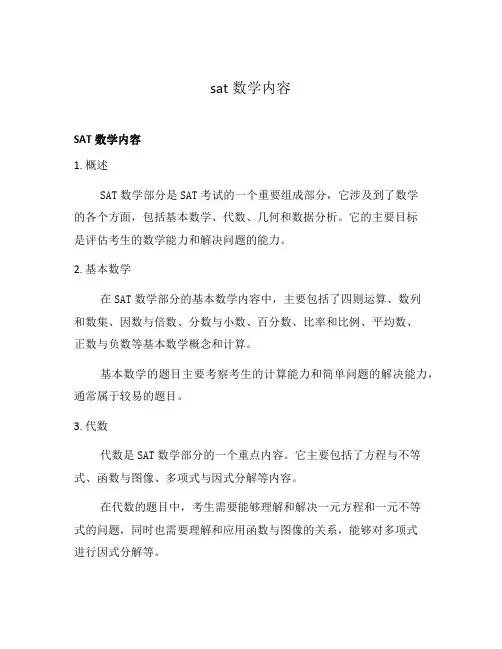
sat数学内容SAT数学内容1. 概述SAT数学部分是SAT考试的一个重要组成部分,它涉及到了数学的各个方面,包括基本数学、代数、几何和数据分析。
它的主要目标是评估考生的数学能力和解决问题的能力。
2. 基本数学在SAT数学部分的基本数学内容中,主要包括了四则运算、数列和数集、因数与倍数、分数与小数、百分数、比率和比例、平均数、正数与负数等基本数学概念和计算。
基本数学的题目主要考察考生的计算能力和简单问题的解决能力,通常属于较易的题目。
3. 代数代数是SAT数学部分的一个重点内容。
它主要包括了方程与不等式、函数与图像、多项式与因式分解等内容。
在代数的题目中,考生需要能够理解和解决一元方程和一元不等式的问题,同时也需要理解和应用函数与图像的关系,能够对多项式进行因式分解等。
4. 几何几何也是SAT数学部分的一个重要内容。
主要包括平面几何和立体几何。
在几何的题目中,考生需要理解和应用几何图形的性质和定理,能够解决与角度、长度、面积和体积相关的问题。
5. 数据分析数据分析也是SAT数学部分的一个考点。
它主要包括统计学和概率。
在数据分析的题目中,考生需要理解和解决与数据收集、处理和分析相关的问题,能够理解和应用概率的基本概念和计算方法。
总结SAT数学部分包括基本数学、代数、几何和数据分析等内容。
考生需要通过对这些内容的理解和应用,展示出自己的数学能力和解决问题的能力。
熟练掌握各个知识点,并进行充分的练习和复习,对于提高SAT数学的得分至关重要。
6. 解题技巧和策略为了更好地应对SAT数学题目,考生可以采用一些解题技巧和策略来提高效率和准确性。
•首先,仔细阅读题目,理解题目的要求和条件。
确保对题目的要求和给定信息有清晰而准确的理解。
•其次,画图是解决几何问题的常用方法。
画出几何图形,利用图形性质和定理来解决问题。
•在解答代数题目时,可以使用代数符号来简化问题。
将问题抽象化,利用代数方法进行求解。
•有时,问题可以通过反证法来解决。
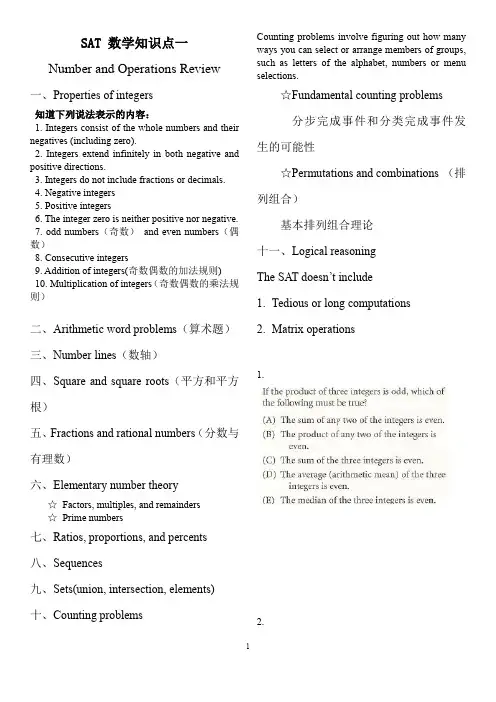
SAT 数学知识点一Number and Operations Review 一、Properties of integers知道下列说法表示的内容:1. Integers consist of the whole numbers and their negatives (including zero).2. Integers extend infinitely in both negative and positive directions.3. Integers do not include fractions or decimals.4. Negative integers5. Positive integers6. The integer zero is neither positive nor negative.7. odd numbers(奇数)and even numbers(偶数)8. Consecutive integers9. Addition of integers(奇数偶数的加法规则)10. Multiplication of integers(奇数偶数的乘法规则)二、Arithmetic word problems(算术题)三、Number lines(数轴)四、Square and square roots(平方和平方根)五、Fractions and rational numbers(分数与有理数)六、Elementary number theory☆Factors, multiples, and remainders☆Prime numbers七、Ratios, proportions, and percents八、Sequences九、Sets(union, intersection, elements)十、Counting problems Counting problems involve figuring out how many ways you can select or arrange members of groups, such as letters of the alphabet, numbers or menu selections.☆Fundamental counting problems分步完成事件和分类完成事件发生的可能性☆Permutations and combinations (排列组合)基本排列组合理论十一、Logical reasoningThe SAT doesn’t include1.Tedious or long computations2.Matrix operations1.2.3.4.5. 6.7.8.9.10.11.12.13. 14.SAT数学知识点二Algebra and Functions Review Many math questions require knowledge of algebra. This chapter gives you some further practice. You have to manipulate and solve a simple equation for an unknown, simplify and evaluate algebraic expressions, and use algebraic expressions, and use algebraic concepts in problem-solving situations.For the math questions covering algebra and functions content, you should be familiar with all of the following basic skills and topics:一、Operations on algebraic expressions二、Factoring三、Exponents四、Evaluating expressions with exponents and roots五、Solving equations☆Working with “unsolvable” equations☆Solving for one variable in terms of another☆Solving equations involving radical expressions六、Absolute value 七、Direct translation into mathematical expressions八、Inequalities九、Systems of linear equations and inequalities十、Solving quadratic equations by factoring 十一、Rational equations and inequalities 十二、Direct and inverse variation十三、Word problems十四、Functions☆Function notation and evaluation☆Domain and range☆Using new definitions☆Functions as models☆Linear functions: their equations and graphs☆Quadratic functions: their equations and graphs☆Qualitative behavior of graphs and functions☆Translations and their effects on graphsand functionsThe SAT doesn’t include:一、Solving quadratic equations thatrequire the use of the quadraticformula二、Complex numbers三、Logarithms1.2.3.4. 5.6.7.8.9.10.SAT 数学知识点三Geometry and Measurement Review Concept you should to knowFor the mathematics questions covering geometry and measurement concepts, you should be familiar with all of the following basic skills, topics, and formulas:一、Geometric notation二、Points and lines三、Angles in the plane四、Triangles(including special triangles)☆Equilateral triangles☆Isosceles triangles☆Right triangles and the Pythagorean theorem ☆30º-60º-90ºtriangles☆45º-45º-90ºtriangles☆3-4-5 triangles☆Congruent triangles☆Similar triangles☆The triangle inequality五、Quadrilaterals☆Parallelograms☆Rectangles☆Squares六、Areas and Perimeters☆Areas of squares and rectangles☆Perimeters of squares and rectangles☆Area of triangles☆Area of Parallelograms七、Other polygons☆Angles in a polygon☆Perimeter☆Area八、Circles☆Diameter☆Radius☆Arc☆Tangent to a circle☆Circumference☆Area九、Solid geometry☆Solid figures and volumes☆Surface area十、Geometric perception十一、Coordinate geometry☆Slopes, parallel lines, and perpendicular lines☆The midpoint formula☆The distance formula十二、TransformationsThe SAT doesn’t include:一、Formal geometric proofs二、Trigonometry三、Radian measure1.2.3.4.5.6. 7.8.9.SAT 数学知识点四Data Analysis, Statistics andProbability ReviewFor the math questions covering data analysis, statistics and probability concepts, you should be familiar with all of the following basic skills and topics:一、Data interpretation二、Statistics☆Arithmetic mean☆Median☆Mode☆Weighted average☆Average of algebraic expression☆Using average to find missing numbers三、Elementary probability四、Geometric probabilityThe SAT doesn’t include:四、Computation of standard deviation 1.2.3.4.5. 6.7.8.Word Problems1.2.3.4. 5-75.6.7.1112。
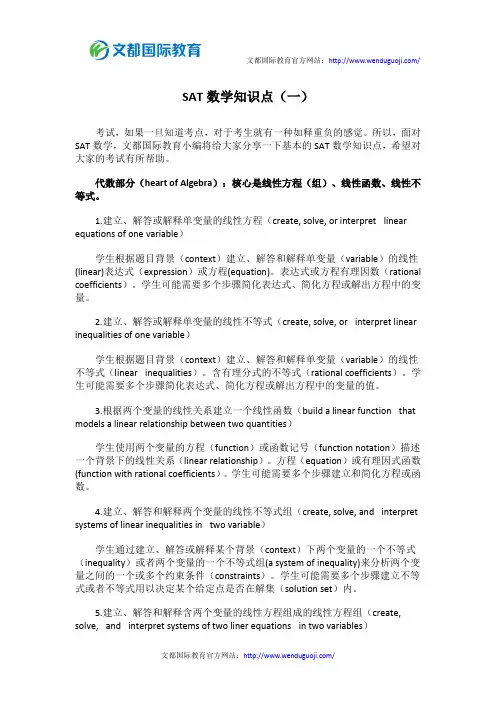
SAT数学知识点(一)考试,如果一旦知道考点,对于考生就有一种如释重负的感觉。
所以,面对SAT数学,文都国际教育小编将给大家分享一下基本的SAT数学知识点,希望对大家的考试有所帮助。
代数部分(heart of Algebra):核心是线性方程(组)、线性函数、线性不等式。
1.建立、解答或解释单变量的线性方程(create, solve, or interpret linear equations of one variable)学生根据题目背景(context)建立、解答和解释单变量(variable)的线性(linear)表达式(expression)或方程(equation)。
表达式或方程有理因数(rational coefficients)。
学生可能需要多个步骤简化表达式、简化方程或解出方程中的变量。
2.建立、解答或解释单变量的线性不等式(create, solve, or interpret linear inequalities of one variable)学生根据题目背景(context)建立、解答和解释单变量(variable)的线性不等式(linear inequalities)。
含有理分式的不等式(rational coefficients)。
学生可能需要多个步骤简化表达式、简化方程或解出方程中的变量的值。
3.根据两个变量的线性关系建立一个线性函数(build a linear function that models a linear relationship between two quantities)学生使用两个变量的方程(function)或函数记号(function notation)描述一个背景下的线性关系(linear relationship)。
方程(equation)或有理因式函数(function with rational coefficients)。
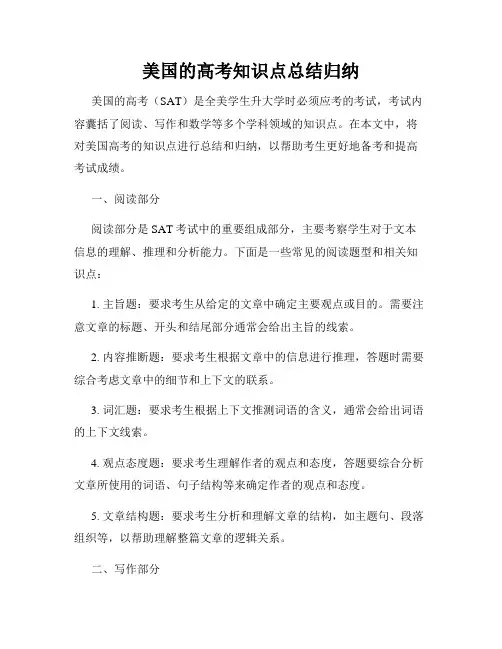
美国的高考知识点总结归纳美国的高考(SAT)是全美学生升大学时必须应考的考试,考试内容囊括了阅读、写作和数学等多个学科领域的知识点。
在本文中,将对美国高考的知识点进行总结和归纳,以帮助考生更好地备考和提高考试成绩。
一、阅读部分阅读部分是SAT考试中的重要组成部分,主要考察学生对于文本信息的理解、推理和分析能力。
下面是一些常见的阅读题型和相关知识点:1. 主旨题:要求考生从给定的文章中确定主要观点或目的。
需要注意文章的标题、开头和结尾部分通常会给出主旨的线索。
2. 内容推断题:要求考生根据文章中的信息进行推理,答题时需要综合考虑文章中的细节和上下文的联系。
3. 词汇题:要求考生根据上下文推测词语的含义,通常会给出词语的上下文线索。
4. 观点态度题:要求考生理解作者的观点和态度,答题要综合分析文章所使用的词语、句子结构等来确定作者的观点和态度。
5. 文章结构题:要求考生分析和理解文章的结构,如主题句、段落组织等,以帮助理解整篇文章的逻辑关系。
二、写作部分写作部分是SAT考试中的另一个重要组成部分,一般包括一个独立写作任务和一个综合写作任务。
以下是一些常见的写作知识点:1. 独立写作:要求考生针对某个主题或观点,提出自己的观点,并支持自己的观点。
在写作过程中,需要注意清晰地陈述自己的观点,使用适当的例子和论据来支持观点,并注意文章的逻辑结构和语法错误。
2. 综合写作:要求考生阅读一篇文章和一个演讲稿,然后对两者进行综合分析和评价。
在写作过程中,需要准确理解文章和演讲的主要观点,分析作者使用的论据和证据,发现文章和演讲的异同之处,并提供自己的评价和观点。
三、数学部分数学部分是SAT考试中的另一大考点,主要考察考生的数学运算、代数、几何和数据分析等方面的知识点。
以下是一些常见的数学知识点:1. 数学运算:涉及基本的四则运算、百分数、整数、有理数、无理数、正负数等的运算规则和性质。
2. 代数:包括代数方程、函数、解方程和代数表达式的化简等内容。
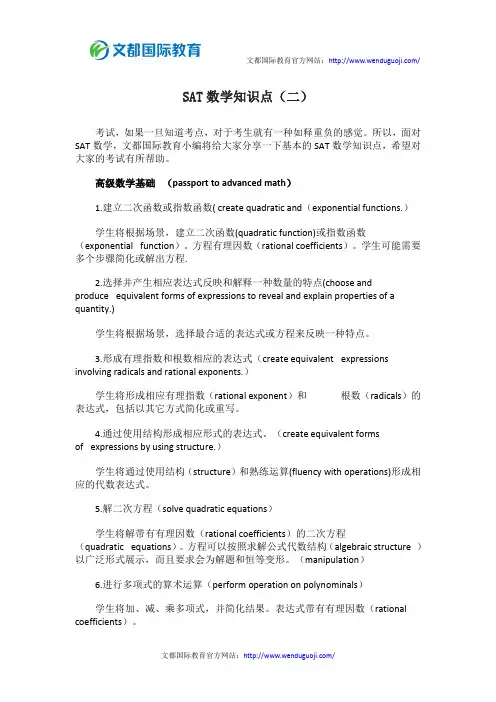
SAT数学知识点(二)考试,如果一旦知道考点,对于考生就有一种如释重负的感觉。
所以,面对SAT数学,文都国际教育小编将给大家分享一下基本的SAT数学知识点,希望对大家的考试有所帮助。
高级数学基础(passport to advanced math)1.建立二次函数或指数函数( create quadratic and(exponential functions.)学生将根据场景,建立二次函数(quadratic function)或指数函数(exponential function)。
方程有理因数(rational coefficients)。
学生可能需要多个步骤简化或解出方程.2.选择并产生相应表达式反映和解释一种数量的特点(choose andproduce equivalent forms of expressions to reveal and explain properties of a quantity.)学生将根据场景,选择最合适的表达式或方程来反映一种特点。
3.形成有理指数和根数相应的表达式(create equivalent expressions involving radicals and rational exponents.)学生将形成相应有理指数(rational exponent)和根数(radicals)的表达式,包括以其它方式简化或重写。
4.通过使用结构形成相应形式的表达式。
(create equivalent formsof expressions by using structure.)学生将通过使用结构(structure)和熟练运算(fluency with operations)形成相应的代数表达式。
5.解二次方程(solve quadratic equations)学生将解带有有理因数(rational coefficients)的二次方程(quadratic equations)。
饱和函数sat
饱和函数sat是一种在数学和计算机科学领域中使用广泛的函数。
它的定义如下:令x为任意实数,则饱和函数sat(x)=1,当x ≤0时;sat(x)=x,当0<x<1时;sat(x)=1,当x≥1时。
饱和函数sat通常被用来表示“饱和”或“限制”,即变量x被限制在[0,1]区间内。
它也是许多算法中使用的数学函数,如信号处理、机器学习、数值优化、深度学习等。
饱和函数sat的应用很广泛:
(1)在信号处理中,饱和函数sat可用于缩放和限制信号的范围。
(2)在自然语言处理中,饱和函数sat可用于将文本转换为机器学习模型可以理解的形式,从而改善文本分类等任务的性能。
(3)在机器学习中,饱和函数sat可用于归一化数据、调整神经网络的输出,以及调整训练算法的收敛。
(4)在监督学习中,饱和函数sat可以用于缩放标签值、控制训练样本的分布,以及控制错误函数的梯度增长。
(5)在深度学习中,饱和函数sat可用于控制激活函数的输出和梯度传播,以及控制损失函数的更新。
(6)在模式识别中,饱和函数sat可用于衡量不同样本之间的相似度,从而改善模式识别结果。
因此,饱和函数sat在数学和计算机科学中的应用很广泛,为很多技术做出了重要贡献,例如信号处理、机器学习、数值优化、自然
语言处理、监督学习以及深度学习等。
总之,饱和函数sat是一种非常重要的数学函数,它在许多领域中使用广泛,有着重要的应用价值。
其更重要的是,它能极大地提高计算机系统的性能,从而满足人们更高的要求。
SAT数学的常见考点总结SAT数学考试是很多同学们头疼的一门科目,其中包含了各种各样的考点。
为了使大家更好地备考和应对SAT数学考试,下面将对常见的考点进行总结和详细介绍。
1. 代数与函数(Algebra and Functions)1.1 代数表达式求解问题SAT数学考试中经常涉及到解代数表达式的问题,题目可能要求化简、合并同类项、分解因式等。
1.2 方程与不等式方程与不等式也是SAT数学中的重点考察内容,包括一元二次方程的求解、解不等式时的符号方向、绝对值等。
1.3 函数与图像对于函数与图像的考察,题目可能涉及恒等函数、线性函数、二次函数、指数函数、对数函数以及复合函数的求解等。
1.4 概率与统计概率与统计是SAT数学考试中单项选择题和多项选择题中的常见考点,涉及到事件概率、抽样、标准差等。
2. 数据分析与问题解决(Data Analysis and Problem Solving)2.1 数据集合与表示这部分考察了数据集合的表示方法,例如直方图、折线图、饼图等,还包括对数据集合的读图和解读。
2.2 数据解释与分析题目可能涉及数据之间的关系、趋势、规律以及数据的有效性等问题,需要学生根据提供的数据进行分析和解释。
2.3 概率与统计此部分需要掌握各种概率与统计的概念和方法,如期望、标准差、置信区间、相关系数等。
3. 几何与测量(Geometry and Measurement)3.1 平面几何和空间几何几何相关的考点囊括了平面几何和空间几何,包括点、线、面的性质和关系,以及角度、距离、周长、面积、体积等计算。
3.2 相似性和比例这一部分主要考察相似三角形和相似图形之间的比例关系,以及比例的应用,如相似三角形的边长比、面积比等。
3.3 记数与排列组合题目可能涉及用排列组合的方法计数,如从一组数中选取特定数字的不同方式数目等。
4. 其他相关数学概念4.1 数列与数列求和SAT数学考试中常涉及等差数列、等比数列等,需要求解数列的通项公式和求和公式。
sat机考数学考点
SAT机考数学的考点主要包括以下几个方面:
1. 算术运算:包括整数、分数、小数、百分数、比例和比率、平均数、中位数、模式等基本的数学运算。
2. 代数:代数式的简化、方程和不等式的解、函数的定义和图像、多项式的运算等。
3. 几何:包括平面几何和立体几何,需要了解它们的基本概念和性质,如直线、角度、三角形、四边形、圆、体积等。
4. 数据分析与统计:包括数据的收集、整理、表示和分析,以及概率和统计的基本概念和方法。
此外,考生还需要注意以下变化:
1. 计算器的使用:考试全程允许使用计算器,考生应提前熟悉计算器的各类功能。
2. 填空题的变化:填空题可填负数答案,考生在判断填空题答案时需要考虑负数的情况。
3. 题干的简短化:这降低了数学理解的难度,考生可更专注于数学知识本身。
以上信息仅供参考,建议考生通过做真题来深入理解题型和考点变化,以便高效备考。
1、有关基本运算:add,plus加subtract减difference差multiply, times乘product积divide除divisible可被整除的divided evenly被整除dividend被除数divisor因子,除数quotient商remainder余数factorial阶乘power乘方radical sign, root sign根号round to四舍五入to the nearest四舍五入2.有关集合union并集proper subset真子集solution set解集3.有关代数式、方程和不等式algebraic term代数项like terms,similar terms同类项numerical coefficient数字系数literal coefficient字母系数inequality不等式triangle inequality三角不等式range值域original equation原方程equivalent equation同解方程等价方程linear equation线性方程(e.g.5 x +6=22)4.有关分数和小数proper fraction真分数improper fraction假分数mixed number带分数vulgar fraction,commonfraction普通分数simple fraction简分数complex fraction繁分数numerator分子denominator分母(least)common denominator(最小)公分母quarter四分之一decimal fraction纯小数infinite decimal无穷小数recurring decimal循环小数tenths unit十分位5.基本数学概念arithmetic mean算术平均值weighted average加权平均值geometric mean几何平均数exponent指数,幂base乘幂的底数,底边cube立方数,立方体square root平方根cube root立方根common logarithm常用对数digit数字constant常数variable变量inverse function反函数complementary function余函数linear一次的,线性的factorization因式分解absolute value绝对值,e.g.|-32|=32round off四舍五入6.有关数论natural number自然数positive number正数negative number负数odd integer, odd number奇数even integer, even number偶数integer, whole number整数positive whole number正整数negative whole number负整数consecutive number连续整数real number, rational number实数,有理数irrational(number)无理数inverse倒数composite number合数e.g.4,6,8,9,10,12,14,15……prime number质数e.g.2,3,5,7,11,13,15……reciprocal倒数common divisor公约数multiple倍数(least)common multiple(最小)公倍数(prime)factor(质)因子common factor公因子ordinary scale, decimal scale十进制nonnegative非负的tens十位units个位mode众数median中数common ratio公比7.数列arithmeticprogression(sequence)等差数列geometricprogression(sequence)等比数列8.其它approximate近似(anti)clockwise(逆)顺时针方向cardinal基数ordinal序数direct proportion正比distinct不同的estimation估计,近似parentheses括号proportion比例permutation排列combination组合table表格trigonometric function三角函数unit单位,位1.所有的角alternate angle内错角corresponding angle同位角vertical angle对顶角central angle圆心角interior angle内角exterior angle外角supplementary angles补角complementary angle余角adjacent angle邻角acute angle锐角obtuse angle钝角right angle直角round angle周角straight angle平角included angle夹角2.所有的三角形equilateral triangle等边三角形scalene triangle不等边三角形isosceles triangle等腰三角形right triangle直角三角形oblique斜三角形inscribed triangle内接三角形3.有关收敛的平面图形,除三角形外semicircle半圆concentric circles同心圆quadrilateral四边形pentagon五边形hexagon六边形heptagon七边形octagon八边形nonagon九边形decagon十边形polygon多边形parallelogram平行四边形equilateral等边形plane平面square正方形,平方rectangle长方形regular polygon正多边形rhombus菱形trapezoid梯形4.其它平面图形arc弧line, straight line直线line segment线段parallel lines平行线segment of a circle弧形5.有关立体图形cube立方体,立方数rectangular solid长方体regular solid/regularpolyhedron正多面体circular cylinder圆柱体cone圆锥sphere球体solid立体的6.有关图形上的附属物altitude高depth深度side边长circumference, perimeter周长radian弧度surface area 表面积volume体积arm直角三角形的股cross section横截面center of a circle圆心chord弦radius半径angle bisector角平分线diagonal对角线diameter直径edge棱face of a solid立体的面hypotenuse斜边included side夹边leg三角形的直角边median of a triangle三角形的中线base底边,底数(e.g.2的5次方,2就是底数)opposite直角三角形中的对边midpoint中点endpoint端点vertex(复数形式vertices)顶点tangent切线的transversal截线intercept截距7.有关坐标coordinate system坐标系rectangular coordinate直角坐标系origin原点abscissa横坐标ordinate纵坐标number line数轴quadrant象限slope斜率complex plane复平面8. 其它plane geometry平面几何trigonometry三角学bisect平分circumscribe外切inscribe内切intersect相交perpendicular垂直Pythagorean theorem勾股定理congruent全等的multilateral多边的。
2024年SAT考试专题数学历年题目归纳随着时间的推移,SAT考试的数学部分一直是考生们关注和备考的重点之一。
为了帮助考生更好地准备2024年的SAT考试,本文将对历年数学考题进行归纳和总结。
通过对这些题目的了解和分析,考生们可以更好地理解考试内容和题型,提升数学解题能力,为顺利应对2024年的SAT考试做好准备。
第一部分:基础数学知识在历年的SAT考试中,基础数学知识占据了相当大的比重。
这些题目主要考察考生对数学概念和计算能力的掌握程度。
下面是一些常见的基础数学题目类型:1. 分数运算题:题目要求考生进行分数的加减乘除运算,考查考生对分数的理解和计算能力。
2. 百分数转换题:题目给出一些数值,要求将其转换成百分数形式,或者将百分数转换成小数或分数形式。
3. 根式运算题:考生需要对根式进行化简、加减乘除等运算。
4. 数据解析题:题目给出一组数据,要求考生根据数据进行分析和计算,得出结论。
第二部分:代数与方程代数与方程是SAT考试数学部分的重点内容之一。
下面是一些历年的代数与方程题目类型:1. 一元一次方程题:要求考生解一元一次方程,包括一步、两步或多步解题过程。
2. 二元一次方程组题:给出一个二元一次方程组,要求考生求解方程组的解。
3. 不等式题:考生需要解不等式或者找出不等式的解集。
4. 函数题:题目要求考生分析并绘制函数图像,或者根据函数图像进行分析和计算。
第三部分:几何与三角函数几何与三角函数是SAT考试数学部分的另一个重要内容。
以下是一些历年的几何与三角函数题目类型:1. 三角函数计算题:要求考生根据给定的三角函数值求解角度,或者根据角度值计算三角函数的值。
2. 直角三角形题:题目给出一个直角三角形,要求考生计算缺失的边长或角度。
3. 圆和圆锥题:考生需要计算圆的周长、面积,或者计算圆锥的体积和表面积。
4. 三角函数图像题:题目给出一个三角函数的图像,要求考生根据图像进行分析并回答相关问题。
大连朗阁SAT培训—数学知识点一、新SAT数学知识点清单:1.核心代数(1)线性方程、不等式和线性函数考点:线性方程、线性不等式的解法,线性函数的应用.易错点:线性不等式解题过程中易出错例:In 2014,Country X had 783 miles of paved roads. Starting in 2015, the country has been building 8 miles of new paved roads each year. At this rate, how many miles of paved roads will country have in 2030?(OG P234)分析:这是典型的线性函数的应用。
设未来的某一年到2014相隔有n年,则总里程数F(n)=783+8n.那么,2030年与2014年相隔16年,将n=16带入,有F(16)=911.(2)绝对值考点:绝对值的概念、绝对值不等式的解法易错点:a)原点处的绝对值b)绝对值不等式的解法例:The stratosphere is the layer of the Earth’s atmosphere that is more than 10 kilometers(km) and less than 50 km above the Earth’s surface. Which of thefollowing inequalities describes all possible heights x, in km, above the Earth’s surface that are in the stratosphere?(OG P236)(A)x+10<50(B)x−10<50(C)x+30<20(D)x−30<20分析:这道题乍看起来似乎有难度,但是如果理解了绝对值的本质就非常容易了。
SAT数学知识点总结
青岛新航道学校为大家整理的SAT数学知识点,非常详细,按照相应的知识体系对知识点进行了一些梳理。
大家在备考SAT数学考试的时候可以根据自己的实际情况,对相应的内容进行整理和借鉴。
VIII TRIGONOMETRY
A. Trigonometry of the right triangle
1 Definitions of the six functions
2 Relations of the functions of the complementary angles
3 Reciprocal relations among the functions
4 Variations in the functions of acute angles
5 Pythagorean and quotient relations
6 Functions of 30°, 45°, and 60°
7 Applications of the functions to right triangle problems
B. Trigonometric functions of the general angle
1 Generating an angle of any size
2 Radians and degrees
3 Using radians to determine arc length
4 Definitions of the functions of an angle
5 Signs of the functions in the four quadrants
6 Functions of the quadrantal angle
7 Finding the value of functions of any angle
C Identities and equations
1 Difference between identities in equations
2 Proving identities
3 Solving linear trigonometric functions
4 Solving trigonometric quadratic equations
D Generalized trigonometric relationships
1 Functions of the sum of two angles
2 Functions of the difference of two angles
3 Functions of the double angle
4 Functions of the half angle
E Graphs of trigonometric functions
1 Graphs of the sine, cosine, and tangent curves
2 Properties of the sine, cosine, and tangent curves
3 Definitions of amplitude, period, and frequency
4 Solving trigonometric equations graphically
F Solutions of oblique triangles
1 Law of sines
2 Law of cosines
3 Using logarithms to solve oblique triangle problems
4 Vector problems—parallelogram of forces
5 Navigation problems
IX MISCELLANEOUS TOPICS
A. Complex numbers
1 Meaning
2 Operations
a) Addition and subtraction
b) Multiplication and division
i Powers of i
ii Complex conjugate
3 Complex roots of quadratic equations
B Number Bases
1 Converting from base 10 to other bases
2 Converting from other bases to base 10
3 Operations in other bases
C Exponents and logarithms
1 Meaning of logarithms
2 Computation with exponents and logarithms
3 Equations
4 Graphs of exponential and logarithmic functions
D Binary operations
1 Definition of binary operations
2 Properties of binary operations
3 Application to modular arithmetic
E Identity and inverse elements
1 Addition
2 Multiplication
3 Other operations。